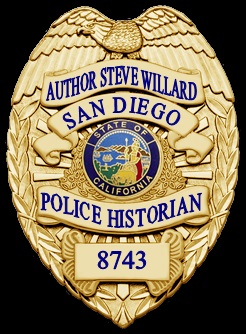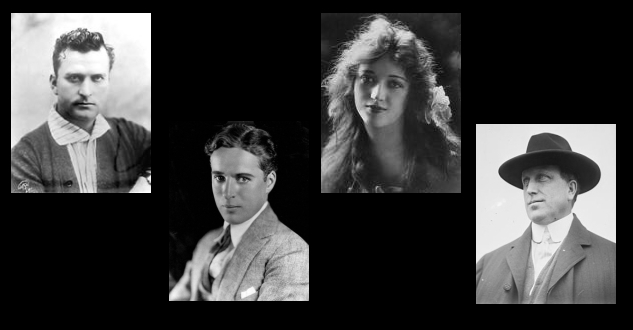Thomas Harper Ince was once the biggest name in Hollywood. Affectionately known as “The Father of the Western,” Ince personally directed more than 800 films and built the first major Hollywood studio. Two Ince films, “The Italian” made in 1915 and “Civilization” in 1916 were selected for preservation by the National Film Registry. o a
Ince later partnered with legendary directors D.W. Griffith and Mack Sennett to form the Triangle Motion Picture Company, whose studios are the present-day site of Sony Pictures. Ince also built a studio a mile from Triangle which is now the site of Culver Studios.
At one time the only names bigger than Thomas Ince was silent film star Charlie Chaplin and newspaper tycoon William Randolph Hearst. So when they all set sail aboard a private yacht, and the 44-year-old Ince later died, there was bound to be controversy.
Despite the official cause of death listed as heart failure, for almost 100 years books and movies have fueled mystery and intrigue around his demise. Hearst’s granddaughter Patricia Hearst — who’d gained notoriety through her kidnapping and subsequent bank robberies — became intrigued with the story and wrote the novel Murder at San Simeon. Released in 1996, the book portrays Chaplin and 27-year-old Hollywood starlet Marion Davies as lovers with a jealous and angry William accidentally shooting Ince.
As recently as 2001, the Peter Bogdanovich movie, “The Cat’s Meow” hypothesized Ince was murdered by William Randolph Hearst in a fit of jealous rage.
So what really happened? And did local law enforcement help cover up a murder?
November 1924: Ince and Hearst were in negotiations for the print mogul to use Ince's studio for Hearst's Cosmopolitan Productions, a film and publishing conglomeration that produced a number of movies including the 1922 extravaganza “When Knighthood Was in Flower.” With production costs of $1.8 million the project was the most expensive picture ever made at the time.
Marion Davies was the breadwinner for Cosmopolitan. Despite evidence of Davies romantic involvement with her older, married boss, the scandal remained mostly out of the public eye.
November 15th: Hearst invited Ince on a cruise to celebrate Ince's birthday and to finalize details of the Cosmopolitan deal. Also invited were Marion Davies, Charlie Chaplin and Dr. Daniel Goodman among others. Despite his importance, Ince wound up being delayed for departure so the lavish 280-foot yacht, the Oneida, set sail from San Pedro for San Diego without him.
Ince took the train to San Diego where he joined the guests the next morning. The group celebrated his birthday that night but later Ince reportedly suffered an acute bout of indigestion after consuming salted almonds and champagne. Ince left the yacht the next morning. Accompanied by Dr. Goodman, the pair eventually checked into a Del Mar hotel where Ince was treated by a second doctor. Ince then summoned his wife and personal physician, Dr. Ida Glasgow to Del Mar. Ince's eldest son William later joined the group.
The group returned to Los Angeles where Ince died in his Benedict Canyon home. Nell later stated her husband had been treated for chest pains caused by angina, but years later William became a physician and said that his father's illness resembled thrombosis. Dr. Glasgow signed the death certificate citing heart failure.
Then things got strange. The front page of the November 19, 1924, morning edition of the Los Angeles Times proclaimed, "Movie Producer Shot on Hearst Yacht!"
Within hours the sensational headlines were retracted for the Times evening edition. The next day the Times published Ince's obituary citing heart disease as the cause of death along with failing health from a 1922 automobile accident. One month later, the New York Times reported the San Diego District Attorney announced Ince's death was caused by heart failure and no further investigation was necessary. As it turned out nor was it possible. Ince and his wife were practicing Theosophists who preferred cremation and arranged for it long before his death. While rumors prevailed that Ince's widow suddenly departed the country after her husband's death, she actually left for Europe seven months later.
Conflicting stories continued to circulate. The most common was Hearst shot Ince in the head after he walked into the yachts galley at midnight and saw what he thought was Marion Davies and Charlie Chaplin romantically intertwined. According to the rumors Hearst was already suspicious of an affair between Davies and Chaplin. The scenario was made even more plausible given Ince and Chaplin bore a strong physical resemblance.
Chaplin's valet, Toraichi Kono, later claimed he saw Ince "bleeding from a head wound" when he was brought ashore at the Broadway Pier.
Other supposed witnesses offered similar stories.
Rumors quickly spread throughout Beverly Hills. During Ince's funeral, the Times noted no witnesses ever mentioning a bullet wound during the open-casket funeral. Given the shot was allegedly to the back of the head, the article may not have held much relevance.
Years later, Hearst spoke to a journalist about the homicide rumors: "Not only am I innocent of the Ince murder", he declared, "so is
everybody else."
In her 1970 autobiography Nell Ince rhetorically asked, "Do you think I’d have done nothing if I suspected my husband had been victim of foul play?"
Regardless of what really happened, the incident changed Hearst forever. D.W. Griffith remarked in later years, “All you have to do to
make Hearst turn white as a ghost is mention Ince’s name. There’s plenty wrong there but Hearst is too big to touch.”
Today William Randolph Hearst and Thomas Ince are memorialized in very different ways. His former home, a giant hillside San Simeon castle bearing the Hearst family name, is one of California’s most popular tourist attractions.
A star, one of thousands along the busy sidewalks that now define the Hollywood Walk of Fame is all that memorializes Thomas Ince. It’s located in front of a storefront at 6727 Hollywood Blvd.

The CRIME FILES



Thomas Ince
Marion Davies
W.R. Hearst
Charlie Chaplin